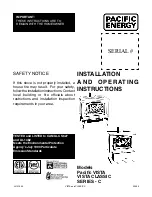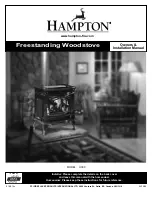
CORN VENT TYPE
CORN VENT MUST MAINTAIN A
MINIMUM 3” CLEARANCE TO ANY
COMBUSTIBLE (INSTALL VENT AT
CLEARANCES SPECIFIED BY THE
VENT MANUFACTURER)
DO NOT CONNECT THE
CORN VENT TO A VENT
SERVING ANY OTHER
APPLIANCE OR STOVE
Corn venting must be approved 3” or 4” diameter type PL or L. You must vent your stove directly to the
outside in one of the configurations shown in the diagram below.
CORN VENT INSTALLATION
Termination must exhaust above the air inlet elevation and parallel or above the exhaust output of the
pellet appliance. It is recommended that at least 3 feet of vertical pipe be installed to create natural draft.
This is to help prevent the possibility of smoke or odor during appliance shut down.
CORN VENT DISTANCE
Maximum venting height is 33 feet. Maximum
horizontal offset is 5 feet. Use no more than 180
of elbows (eg. 2 x 90 elbows, or 2 x 45 elbows &
1 x 90 elbow, etc) plus termination.
Vent must have a support bracket every 5 feet
when on the exterior wall.
Vent height and run
MUST NOT
exceed the
distance shown in the unshaded region of
the chart.
To achieve optimum performance,
KEEP VENT RUNS AS SHORT AS POSSIBLE
,
especially on horizontal installations.
o
o
o
o
Horizontal sections must have a 1/4” rise every 12” of travel after 3 feet.
Corn vent connections must be sealed with high temperature RTV silicone and/or screwed together with a
least 3 x 3/8” long stainless steel screws.
Seal each vent section by injecting a liberal amount of this silicone into the gap.
Use 4” diameter venting if vent or vent liner height is over 15 feet or if the installation is over 4000 feet above
sea level.
DO NOT INSTALL A
FLUE DAMPER IN THE
EXHAUST VENTING SYSTEM
OF THIS UNIT
EXHAUST
SYSTEMS
8
Use
Diameter “PL” Vent
If venting outside of
shaded area.
4”
0’
0’
5’
10’
5’
15’
20’
25’
30’
33’
Use
or
Diameter
“PL” Vent, if venting in
shaded area.
3”
4”
(diagram not to scale)
CORN VENT TERMINATION
Termination must be a minimum of 6” above
the chimney (NOTE: Chimney must meet
local codes for height above the roof or other
obstructions)
There must be an approved cap to prevent
water from entering the pipe shaft, or a 45
elbow downturn
If the termination is located on a windy side of the house, an approved house shield is recommended to
prevent soot from accumulating on the side of the house
There must be a metal seal plate or a wall thimble at the wall juncture
o
Termination must NOT be located where snow or other materials will plug it


































